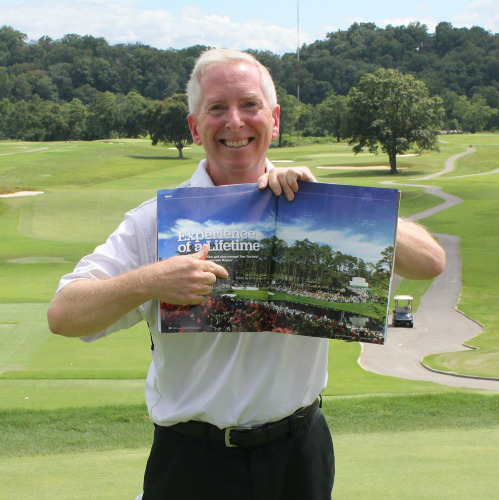
McConnell Golf’s recent purchases of renowned Holston Hills Country Club in Knoxville and Providence Country Club in Charlotte mark inaugural ventures into a pair of new markets — while also tying together the membership network of 12 private golf club properties in the Carolinas and Tennessee. In mid-February, McConnell Golf made its long-awaited arrival to the Charlotte market when Providence became the 12th private golf club property in the McConnell Golf stable, which now includes a total of 225 holes around the Carolinas and Tennessee. Two months earlier, in December 2015, McConnell Golf added to its legacy with the purchase of venerable Holston Hills in Knoxville, a 1927 Donald Ross design that marks the first McConnell Golf club located outside the Carolinas. In line with the wellness initiative, both golf courses are easily walkable, a feature regularly taken advantage of by the membership.
HOLSTON HILLS COUNTRY CLUB OF KNOXVILLE, TENNESSEE
“Our new relationship with McConnell Golf has been wonderful,” says Holston Hills Director of Golf Chris Dibble. “We’ve been truly overwhelmed by the welcome we’ve gotten from every other club in the McConnell Golf family — their entire staffs. Everyone has reached out offering to help in any way. It’s been really nice. We are very excited about the future.” Donald Ross was the most prolific golf course architect in history, with more than 400 designs bearing his signature. Yet today very few Ross golf courses exist as they were originally designed. Most have been altered through the years and lost much of the genius that Ross characteristically imparted on a course. One Ross design that has remained nearly untouched through the years is Holston Hills Country Club in Knoxville, which in December 2015 became the first McConnell Golf Course located outside the Carolinas.
Holston Hills opened in 1927. Located just east of Knoxville near the foothills of the Smoky Mountains on 180 open acres of rolling old farmland tucked into a bend in the Holston River, Holston Hills immediately became recognized as the finest course in the state. Accordingly, it hosted every major regional tournament, including a PGA Tour event.
“If someone blindfolded you, you might think you were playing a golf course back in the late ’20s or early ’30s, playing the golf course the way Ross designed it,” McConnell Golf Director of Golf “Boomer” Kittler says. “You don’t find that much these days. You can stand on No. 16 green at Holston Hills and see all the way to the green of the fifth hole. No matter where you are on the golf course, you can see ten-plus holes without batting an eye. It’s pretty cool. The greens remind me of Sedgefield.
“I’m kind of a ‘Ross guy,’” Kittler says, “but I think Holston Hills will be one of McConnell Golf’s best courses, if not the best.”
Founded by members of Knoxville’s prestigious Cherokee Country Club — itself a 1910 Ross design — where overcrowding had become a problem, Holston Hills further bolsters McConnell Golf’s reputation for having the names of the game’s greatest architects attached to its courses. “Holston Hills is the fourth McConnell Golf course designed by Donald Ross,” says McConnell Golf Chief Operating Officer Christian Anastasiadis. “We are particularly excited to be part of the Knoxville
community. We look forward to doing in Tennessee what we have done at some of the finest private clubs in the Carolinas.” Though relatively low-key and unknown, Holston Hills has been ranked among the country’s greatest classical (pre-1960) golf designs in the United States. The co-founder of the Donald Ross Society and noted golf architecture critic Michael J. Fay has said that he would rather play Holston Hills over any other golf course in the South on a consistent basis.
The beloved untouched Ross layout takes on a broad, fan-shaped formation, with both nines returning to the clubhouse sitting on an upslope along the north side of the property. Holston Hills features more than 100 bunkers scattered across the property, with very few houses or other visual distractions taking away from the links-style playing experience. A 1937 aerial photograph hanging in the clubhouse shows that every tee and green is located just as they are now, and virtually every present-day bunker is accounted for in the image.
Perched on a hill with breathtaking views of the Great Smoky Mountains, the Holston Hills clubhouse overlooks the golf course and showcases bay windows, elegant arched doors, and a central ballroom with large cathedral ceilings and exposed wood trusses. An outdoor terrace on the south side of the ballroom offers members a space to relax and take in the view, while a magnificent centerpiece terrace surrounds the clubhouse, with its comfortable Tudor architecture.
“We think Holston Hills is a pretty special place, and we are excited to be a part of the McConnell Golf team,” says Dibble. “Holston Hills is neat because every hole is right in front of you. It’s very fair. There are no tricks or hidden hazards. [Noted golf course architect] Tom Doak says Holston Hills is the closest golf course around to what Ross originally left.”
PROVIDENCE COUNTRY CLUB OF CHARLOTTE, NORTH CAROLINA
Given the strategic location of McConnell Golf clubs throughout the Carolinas, the Charlotte market has long been the missing piece. The Queen City is as vibrant as it has ever been and the golf-crazed city stands geographically as a centerpiece destination connecting many of McConnell Golf’s 11 other golf properties around the Southeast. McConnell Golf’s February purchase of Providence Country Club changes all that.
Located in southeast Charlotte, Providence Country Club was established in 1989 and has developed a reputation as one of Charlotte’s premier family country clubs. Providence’s pristine 18-hole Dan Maples layout, redesigned by Mike Gleason in 2006, measures 7,021 yards and plays to a par of 72. As it relates to the McConnell Golf family, Maples is the son of longtime Donald Ross protégé Ellis Maples. When Ross passed away in 1948 during construction of Raleigh Country Club, the elder Maples finished the job and served as Raleigh Country Club’s original superintendent and head golf professional. Together, the team of Ellis and Dan Maples helped create 17 outstanding courses including Grandfather Mountain in Linville, North Carolina, and the Country Club of North Carolina Dogwood Course in Pinehurst.
McConnell Golf owner and CEO John McConnell says he has long sought to acquire a country club in the Charlotte market and that the Providence acquisition connects the proverbial dots. “Along with giving us a truly outstanding club in a fast-growing urban area, Providence provides close proximity to several of our other courses including Club of Asheville. Plus Providence is only 90 minutes from Musgrove Mill,” McConnell says. “This deal ties together our entire network of clubs, particularly our corporate memberships.”
McConnell Golf plans to spend the next few years renovating the course using an expert architect, while also providing numerous other substantial improvements around the club. Providence’s extensive amenities include 14 tennis courts and state-of-the-art aquatic facilities, with three swimming pools and a newly constructed outdoor bar and dining area with a fire pit.
“We are planning major improvements during the next several years, totaling around $4 million,” says McConnell Golf COO Christian Anastasiadis. “We will focus on new fitness and activity areas, along with the clubhouse and the golf course with a top recognized architect firm. We expect Providence to be the best club in the area.”
From tee to green, Providence is considered one of the most pristine and challenging golf courses in Charlotte. The layout provides a unique test to the accomplished golfer without polarizing the novice. The originality of Maples’ design equates to five par-5s (three on the back nine), five par-3s (three in the first six holes), and eight par-4 holes, which are always complex and exciting. The uniqueness and beauty of each hole, with bent grass greens and Bermuda fairways, complement five-tiered tee boxes designed to accommodate all skill levels. Practice makes perfect and Providence has it all; multiple first-class putting greens, two short-game practice areas and a full-swing driving range.
“Our club is very family-oriented. We have a lot of young members and a lot of kids,” says longtime Providence Director of Instruction Leslie Elmore, who spent four years after her college career at N.C. State trying her hand on professional tours in Europe and Asia. “We’ve got a very active membership. I give a lot of lessons. We have a warm, welcoming membership. People are very down-to-earth, not pretentious at all.”
A true neighborhood country club, the membership roster is mostly comprised of residents from nearby developments Providence and Providence Crossing.
“The Providence property reminds us a little bit of Wakefield, because it’s very big,” says McConnell Golf Director of Golf Boomer Kittler. “Big membership, big neighborhood, nice clubhouse, good swimming, and tennis facilities. Now it’s just a matter of what we can do to enhance it. Providence has the potential to be really good with the work we are going to do to the golf course. There are some incredible clubs around Charlotte that are tough to compete with — when you think about Quail Hollow, Charlotte Country Club, Myers Park, and places like that — but we think Providence has the ability to take it from a Big Four to a Big Five type deal.”
Read More



